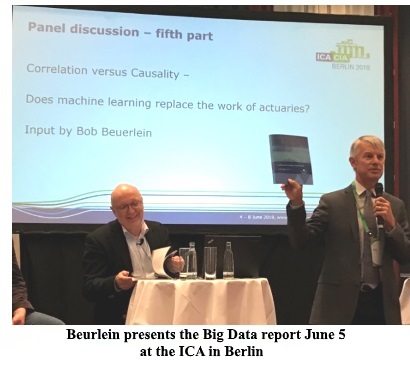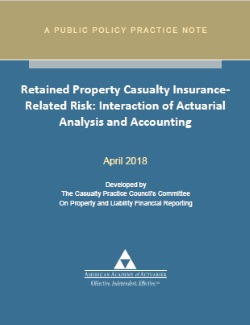 |
|
Summer 2018
VOL 2 | NO 2 |
|
Academy Paper to Look at Catastrophe Modeling
The new paper lays out some of the history of catastrophe modeling—how does this add to and enhance what’s come before? The purpose of the paper is to provide an overview of how catastrophe models have developed and demonstrate how catastrophe model output might be used in selected actuarial tasks. Those who do not use models on a regular basis may find the paper especially useful. It provides a high-level view of how model output might be used but does not get into how models work or how they are developed and maintained. The question that is being answered is “How might an actuary use catastrophe model output?” We’ve heard a lot about catastrophe models for hurricanes. What other applications are there? Hurricane and earthquake catastrophic losses were the first perils for which commercially available models became available. These models have become the standard treatment for many risk applications and are well understood by stakeholders. Models for other causes of loss that have been or are being developed include tornadoes/hail storms and related weather events, inland flooding (which is separate from hurricane storm surge), wildfires, pandemics, and terrorism risks. These each have their own characteristics. The body of knowledge related to these is becoming deeper and the demand for them is also increasing. Do reinsurers use catastrophe models differently than primary insurers? Many of the same models and metrics from these models are the same for primary insurers and reinsurers. There are some differences in emphasis reflecting the coverage and markets for each. For example, reinsurers tend to specialize in various layers of potential loss. As expected, the higher layers (where losses are less frequent and more costly) have greater variability than the primary or lower layers. So, reinsurers tend to focus more on measures of volatility than primary insurers might. Another example could be the granularity (degree of detail) in the exposure data. Since reinsurers often will provide coverage for more than one company and more than one peril, they need aggregated information that reflects similar types of data. If Company A has location information at street level, but Company B has ZIP-code level information, it might be most informative to run all the information at the ZIP-code level for fair comparison. Also, the volume of data that needs to be processed can grow quickly, which can lead to slower model runs, although this is becoming less of a problem with increasing computer power. Catastrophe modeling usually is done by an outside firm. Does this place constraints on how the actuary uses the models? Other circumstances are more likely to produce constraints. The quality of model output is dependent on the quality and timeliness of exposure input. There may be constraints on optimal hardware availability, or on computer or personnel time available. Outside firms will occasionally provide only predefined model output, or may have legal limitations on what they can provide. These are due to factors other than the model itself or its capabilities. Can an insurance company use its own internally developed catastrophe model instead of one that is preapproved by regulators? Insurance companies may find that their internally developed models serve their needs better than one has been preapproved. However, it is a major commitment of resources to develop and maintain models, and few companies are able to do so. If a company is planning to charge rates that are based on catastrophe model output in some U.S. jurisdictions, the regulators may reject the rate filing, or may require substantial (sometimes onerous) information from the insurer about the model. Use of the same catastrophe model may be required for all or some of insurance company audited risk management practices. There is some discussion about a company’s domiciliary regulator allowing internally developed models’ uses, although it is not clear how that would work for a company’s business interest in other jurisdictions. Looking at a particular region, do you run the catastrophe model just once? Do you use models from more than one vendor at a time? What should be done varies with the specific circumstances of a situation. Some companies like to run more than one model and will sometimes combine model results. Others believe that it is preferable to delve deeply into a given model and gain specific insights that are useful to the company, its business and its operations. There is a plethora of potentially useful information that can be obtained from a model. For example, sensitivity testing can help determine whether certain characteristics are of relatively more or less importance. Another consideration is cost and other resources. Catastrophe model software is considered expensive by most entities, and there are related personnel, training, hardware, and update costs. A third party may ameliorate some of these costs if multiple models are needed or preferred. Third parties may limit the output to be provided, often for their own cost reasons. What can we expect if the private sector increases its share of the flood insurance market? Will private insurers be using the same models as the Federal Emergency Management Agency (FEMA)? Significant areas of flood risk under FEMA could be considered overpriced if looked at in more detail than that program has been able to do. That is expected to lead to competition for the insurance coverage for those properties, and catastrophe models are likely to be the tool of choice. Private insurers will most likely prefer to use the models they know and are familiar with rather than adopt FEMA practices. However, there may be logical or legal reasons to follow FEMA for a period of time. Florida seems to be in the forefront of regulating the use of catastrophe models. What can other states learn from them? Florida made some changes following the market devastation after 1992’s Hurricane Andrew. The Florida Hurricane Catastrophe Fund was formed to alleviate the shortage of reinsurance and what some considered its over-pricing. The fund is required to use Florida Commission on Hurricane Loss Projection Methodology (FCHLPM)-approved cat models. The Florida property market has become more stable, and prices have significantly dropped. While it is unclear how much of the fund’s success is due to its establishment and continued prudent administration and how much is due to a fortunate lull in significant events, it is clear that it continues to provide a (mandatory) layer of reinsurance coverage to those companies offering residential property insurance in the state. The FCHLPM reviews catastrophe models to determine if they may be used for residential property insurance ratemaking for policyholders in the state. The every-two-year required submission and subsequent audit required for certification are extensive. The FCHLPM’s review has driven transparency and made some comparisons across different models easier. However, the timing of the review and some of the standardization can create lags in getting the latest models approved in the state. Florida has funded its own catastrophe model, which can be of some use, especially by regulators, in comparing output. However, Florida hurricane-specific geographic and peril coverage, as well as state funding, limit the model in many uses. It does not seem efficient for other states to reproduce what Florida has done. A region- or nationwide effort could be more effective. However, Florida does show that focus on catastrophe models can be beneficial. Conclusion Catastrophe models are valuable tools to quantify various risk management issues related to catastrophe insured exposure. However, model output does not provide “the” answer. The output is quantification of various metrics based on transparent, scientific, documented processes. In addition, it is important to keep in mind that for rates, model output can be used to develop rate or rate change indications which is not always the same as the requested rate. Beuerlein Presents Academy Monograph on Big Data
Speaking June 5 on an ICA panel concerning the role of actuarial associations in data science with representatives of actuarial organizations from the United Kingdom, France, Germany, Finland, as well as other U.S. actuarial organizations, Beuerlein noted that the disruption caused by Big Data in the insurance and other sectors is inevitable and will present both opportunities and challenges. Actuaries have excellent technical skills, he said, but they also bring deep knowledge and experience about business context that will allow them to play significant roles on teams using Big Data. Actuaries also have an important responsibility to the public, Beuerlein said. “We need to think about all of our audiences, and help inform regulators, who are concerned about protecting consumers, on the best way to deal with these issues,” he said, noting that actuaries’ commitment to ethical behavior and to professionalism distinguishes them from other specialists dealing with Big Data. Beuerlein provided examples of how the existing U.S. actuarial standards of practice (ASOPs) on data quality, risk classification, credibility procedures, and communications encompass and require the actuary to transform the “black box” of Big Data into a “transparent box” so “the public can understand what we are doing” and gain trust in the use of these Big Data tools. “As actuaries we have to be more than technicians,” Beuerlein said. “The professionalism around actuaries means we are bringing so much more to the table.” P/C Breakout-Session Topics Set for Annual Meeting
Property/casualty session topics include government-backed P/C insurance programs, climate risk and insurance, and insurance issues in the new sharing and gig economies. This highly focused meeting and policy forum provides attendees with multiple opportunities to engage with policymakers, business leaders, actuaries from all practice areas, and Academy members. Political analyst Charlie Cook of the Cook Political Report will be among the keynote speakers given the meeting is just before the midterm congressional elections, and the professionalism plenary session will feature an interactive game show. And, as usual, we will have some unusual and fun entertainment at our festive dinner between the two days of meetings—this year we are featuring an opportunity to participate in an interactive “Murder Mystery Whodunit,” following the Nov. 1 dinner at Washington’s historic Mayflower Hotel. Register today and join us in November. Academy Responds to NAIC Exposure Draft on CASTF Attestation Charge The Academy submitted a letter May 10 to the NAIC responding to an exposure draft that the NAIC’s Casualty Actuarial and Statistical Task Force (CASTF) has issued containing potential changes to the P/C Statement of Actuarial Opinion Instructions to address the CASTF’s “Attestation” charge and their working definition of “qualified actuary.” Mary D. Miller, past Academy president, submitted the comments on the Academy’s behalf. Actuaries Climate Index Summer 2017 Data Released
Updated values are posted quarterly as data for each meteorological season become available. The organizations are also developing a second index, the Actuaries Climate Risk Index (ACRI), to measure correlations between changes of extreme events as measured by the index and economic losses, mortality, and injuries. Related, Academy Senior Casualty Fellow Kevin Ryan sent a comment letter in late April to the International Association of Insurance Supervisors (IAIS) on the IAIS’ draft while paper on climate change risks to the insurance sector. Among other things, the letter noted the goals of the ACI and the ACRI are to:
Webinar Looks at P/C Public Policy Issues The Casualty Practice Council held its “P/C Public Policy Update—Spring 2018” webinar on April 27. Presenters reviewed the effect of the 2017 federal tax-reform law on P/C insurers, looked at recent legislative and regulatory activity in the states, provided an update on proposed changes in requirements for qualified and appointed actuaries, reviewed the status of the National Flood Insurance Program (NFIP), and provided an update on pending changes to risk-based capital (RBC) bond factors.
Ryan mentioned several NAIC initiatives, including the launch of a white paper on pet health insurance and studying the possible creation of an NAIC in-house group to assist state regulators in their reviews of filings that rely upon predictive modeling. Slides and audio are available free to Academy members. Registration Open: Seminar on Effective P/C Loss Reserve Opinions The Academy will host its annual Seminar on Effective P/C Loss Reserve Opinions, Dec. 6–7, in Chicago. This two-day seminar will provide participants who prepare—or assist in preparing—annual statements of actuarial opinion on P/C loss reserves with information about the latest regulations and standards and included reviews of actuarial qualification standards and interactive case studies. In addition, the seminar will offer attendees the opportunity to:
COPLFR Releases Practice Note on Retained Risk
Because the type of entity often determines the particular approach or applicable accounting treatment, the practice note describes types of entities and the associated variation in retained risk characteristics. A draft of the practice note was released in January, and comments were taken through the end of March. Past Academy President and COPLFR member Mary Frances Miller said in January that the “practice note has been needed for a very long time.” The practice note describes the relevant accounting guidance that apply to entities and exposures, the interaction of the accounting guidance with the relevant actuarial concepts, and variation by type of entity. Several specific situations are described that have particular applicable definitions and considerations. Along with some additional considerations, the practice note also summarizes the actuarial standards of practice that are most applicable to the work described in the practice note. June 25 Webinar: The Academy will host a webinar later this month, “Retained P/C Insurance-Related Risk: Interaction of Actuarial Analysis and Accounting.” Presenters will discuss the new practice note. The presenters will be Past Academy President Mary Frances Miller, a member of the Committee on Property and Liability Financial Reporting; and Lisa Slotznick, vice chairperson of the Casualty Practice Council. The webinar will be held on Monday, June 25, from noon to 1:30 p.m. Register today. Post-NAIC Cross-Practice Alert The Academy’s post-NAIC alert, released in early April, covers all Academy presentations—and related NAIC activity—on public policy and professionalism issues at the NAIC Spring 2018 National Meeting, which was held in Milwaukee in March. Public policy topics included flood insurance, long-term care insurance, variable annuities, and Big Data, among others. Committee Comments on Workers’ Comp The Workers’ Compensation Committee sent comments to the NAIC’s Workers’ Compensation Task Force, describing the difficulty of comparing rates from one state to another. The comments are in response to a request made on a call of the task force during which the Oregon Workers’ Compensation Premium Rate Ranking Report was discussed. Comparing workers’ compensation rates among the states is a significant undertaking, and the letter noted that a study that focuses on the predominant types of employment in one state may not be useful for other states. The letter covered topics including benefit levels (medical and indemnity), wage levels, industry distribution, general economic conditions and demographics, treatment outcomes, pricing practices, and pure premium and expenses.
|
|
Copyright © 2018 American Academy of Actuaries. All Rights Reserved. |

 Big Data and the Role of the Actuary
Big Data and the Role of the Actuary Annual Meeting and Public Policy Forum
Annual Meeting and Public Policy Forum Actuaries Climate Index
Actuaries Climate Index
 practice note
practice note Outstanding Volunteerism Awards
Outstanding Volunteerism Awards